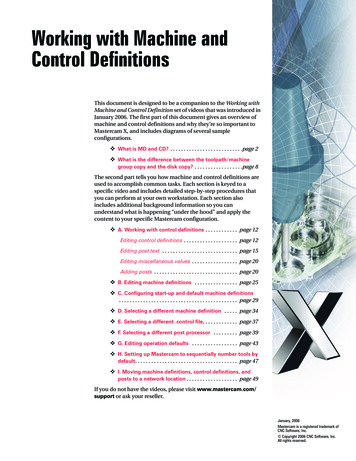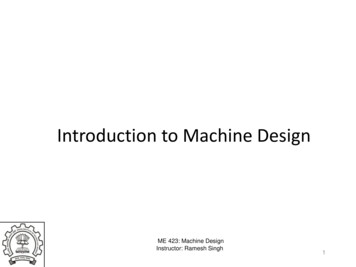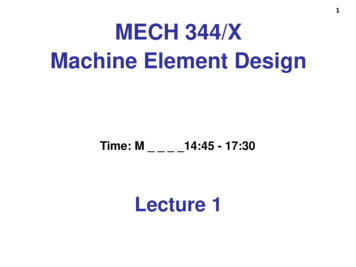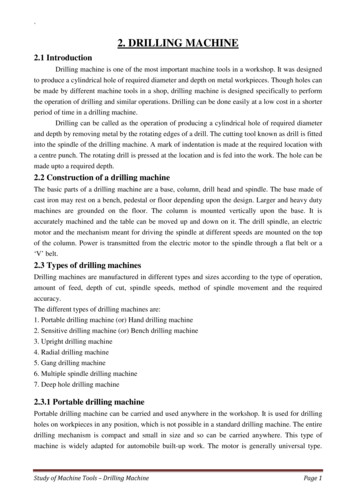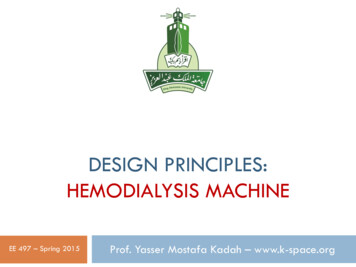
Transcription
DESIGN PRINCIPLES:HEMODIALYSIS MACHINEEE 497 – Spring 2015Prof. Yasser Mostafa Kadah – www.k-space.org
Recommended Reference Allen R. Nissenson and Richard N. Fine (Eds.), Handbook ofDialysis Therapy, 4th ed., Saunders Elsevier, Philadelphia, 2008.(ISBN: 978-1-4160-4197-9)
Hemodialysis Machine
Hemodialysis Machines Single-patient hemodialysis machines deliver a patient’sdialysis prescription by controlling blood and dialysate flowsthrough the dialyzer. Removal of waste metabolitesRemoval of waterHemodialysis machines incorporate monitoring and alarmsystems that protect the patient against adverse events thatmay arise from equipment malfunction during the dialysistreatment.
Hemodialysis System Components(C conductivity monitor, P pressure monitor, T temperature monitor)
Extracorporeal Blood Circuit Consists of an access device (needles or catheter), blood tubing,blood pump, and dialyzer. Role of the blood circuit is to deliver blood to the dialyzer at theprescribed flow rate and then return the blood to the patient. Includes a pump for continuous administration of heparin during dialysis.This goal must be achieved without damaging blood components andwithout loss of circuit integrity that may lead to blood loss or the entry of airor other harmful substances, such as bacteria, into the blood.Urea clearance depends in large part on effective blood flow ratethrough extracorporeal circuit. Established using a roller pump (also known as a rotary peristaltic pump)that allows flows in the range of 50 to 600 mL/min.Blood flow rate setting on the pump is based on the speed of the pump(revolutions/minute) and the volume of pump segment of blood tubing set.
Extracorporeal Blood Circuit Peristaltic pump Safe for blood cells: minimal hemolysisSafe from cross-infection since disposable blood line is used insideCan be operated manually in cases of power outageSpeed controlled by system and also manually
Dialysate Circuit Principal functions of the dialysate circuit: To prepare dialysate from concentrate and waterTo deliver it to the dialyzer at the prescribed temperature (generally35–37ºC) and flow rateTo control fluid removal from the patientDialysate is prepared by the addition of electrolyteconcentrate to warmed and deaerated water. two separate concentrates must be used to prepare dialysateBicarbonate concentrate contains sodium bicarbonate, and in some casessome sodium chloride.Acid concentrate contains all remaining dialysate constituents, a smallamount of acid needed to buffer bicarbonate in final dialysate
Dialyzer Hollow fiber technology Many fine fiber tubes to allow contact surface area to be largeDisposable dialyzers: single patient use to prevent cross-infection
Dialysate proportioning systems System A: Fixed-volumeproportioning of water, acidconcentrate, and bicarbonateconcentrate.System B: Dynamic proportioningusing conductivity measurement tocontrol the acid and bicarbonateconcentrate pumps.System C: Dynamic proportioningusing a powder cartridge to preparethe bicarbonate concentrate onlineA acid concentrateB bicarbonate concentrateCM conductivity monitorCS conductivity set point
Dialysate proportioning systems Several ratios of concentrate to water in common use depending onsystem 1:1.225:32.775, 1:1.83:34, and 1:1.72:42.28 (acid conc: bicarbonate conc:water).Each proportioning ratio requires its own particular acid and bicarbonateconcentrates.Some machines are designed for use with a single proportioningratio, whereas other machines can be set to use differentproportioning ratios.Because machines monitor dialysate composition based onconductivity, use of the wrong concentrates can lead to dialysate ofthe correct conductivity but the wrong composition. Therefore, failure to use the correct machine setting or to use the correctconcentrates with a given machine can lead to patient injury.
Fluid Removal: Ultrafiltration Older systems: no direct control Current systems: volumetric controlSystem A: Flow sensor-based systemSystem B: Balancing chamber system Tricky and depends on dialyserproperties and control of pressureserror leads to excess water removalLeft side of the balancing chambermeters fresh dialysate and the right sidemeters spent dialysateFlow sensors limit dialysate flow rate No limitation with balancing chamber
Cleaning and Disinfection Hemodialysis machines must be cleaned and disinfectedregularly to prevent buildup of chemical and bacterialdeposits in the dialysate flow path Such deposits can interfere with conductivity-based monitoring systemsand flow-meter–based ultrafiltration control systemsTo prevent the chemical buildup of carbonate deposits,machines are rinsed with acetic acid (vinegar) or citric acidTo prevent bacterial buildup, machines must be disinfected atleast daily with a chemical disinfectant such as sodiumhypochlorite (bleach) Some machines also incorporate a hot water disinfection cycle
Monitoring and Control
Safety Monitors in Hemodialysis Dialysate Circuit Prepare the dialysate solution for safe exposure to the patient’s bloodMonitor the dialysate for conductivity and temperatureCirculate the dialysate through the dialyzerRegulate ultrafiltration by volumetric control of the dialysateMonitor the effluent dialysate for blood leaks prior to going to the drainBlood Circuit Circulate the blood outside the body through the dialyzerAnticoagulate the patient’s bloodMaintain blood in a sterile stateMonitor the extracorporeal blood circuit for arterial and venouspressures and the integrity of the circuit for the presence of air andblood leaks
Control Panel and Monitor Display
Monitor Failure All monitors can fail (mechanical, electrical or combination) Machine monitors are frequently thought to be fail-safe devices, butthey are not. A truly fail-safe device cannot be overridden to cause harm either byelectronic or human intervention – obviously not the case in hemodialysisBecause all dialysis machine monitors can fail, they ought to besimple to operate and accurate—and should signal a warning whenthey are out of limits or not working properly. Murphy’s law: If anything can go wrong, it willHuman factors engineering principlesAny important factor requires dual monitoring: the machine monitordevice and dialysis personnel. No machine, computer, or device can replace the continuous surveillance ofhemodialysis personnel.
Dialysate Circuit
Dialysis Monitoring Heater monitoring Thermistor feedback circuit usually controls electrical heating elementsHeater may have a coarse adjustment control inside the machine and afine adjustment control on the front panelDeaeration monitoring Observable by eye and relies on vacuum pump and proper interconnectshidden cause of several serious dialysis problems, such as False bloodleak alarms, False conductivity alarms, Interference with volumetric controlfunction, Decreased dialysis efficiency
Dialysis Monitoring Mixing Device Monitoring Typical mixing ratios of water to dialysate concentrate are: 34:1 or 44:1 for acid concentrate 20:1 or 25:1 for bicarbonate concentrateIf acid and bicarbonate inputs are reversed, or if the wrongconcentrates are used for a bicarbonate machine, the servo loops maymake a solution of acceptable ionic strength (correct conductivity) but oflethal ionic composition.In this case, the pH monitor or concentrate pump speed monitor becomescritical – However, not all machines are equipped with pH monitors
Monitoring Conductivity Conductivity measurement is an estimate of total ionic contentof dialysate, and does not measure or reflect specific ionsConductivity meters usually read the conductivity in millimhosper cm (mmhos/cm) or milliSiemens per cm (mS/cm). Upper and lower set values must be monitored
Bypass System, Monitoring, and RinseMode Bypass system diverts dialysate directly to drain away fromdialyzer to avoid exposure of patient blood to unsafe dialysate Activated by high/low conductivity, high/low pH, or high/low temperatureRinse mode on dialysis machines overrides the bypass system. Itallows rinsing and disinfection of the entire fluid pathway. Should never be activated whilea patient is on dialysis.In newer-model machines, the bloodpump cannot be activated whenthe machine is in the rinse mode
Dialysate Temperature Should be maintained between 37 and 38 CHigh limit should be set at no higher than 41 C Normal red blood cells (RBCs) begin to hemolyze at 42 COverheated dialysate has been known to precipitate cardiac arrhythmias
Blood-Leak Detector and Monitoring This monitor functions by transmitting filtered or unfiltered lightthrough a column of effluent dialysate that exited dialyzer Tears or leaks in the dialyzer membrane cause RBCs to leak into thedialysate, interrupting the light transmissionMachine response to a blood-leak alarm is to effect audible and visualalarms, stop the blood pump, and engage the venous line clamp
Blood Circuit
Arterial / Venous Pressure Monitors Arterial pressure monitor is leakfree with adjustable high/low limits reads negative and positive pressures inmmHg (10% accuracy)During setup, priming, and rinsing of thedialyzer, the high/low limits are openedVenous pressure monitor, locatedpost-dialyzer, monitors pressure atthe venous drip chamber, thesegment between the drip chamberand the patient’s venous access
Air-Foam Detector and Venous Clamp Air-foam detector monitors blood in the venoustubing for the presence of air, foam, andmicrobubblesTwo types of air-foam detectors are in use Ultrasonic and reflected light detectorsUltrasonic type is currently being sold in all new machinesAn air detector alarm must activate the venousclamp
ANSI/AAMI RD5:2003/(R)2008
Ultrafiltration Control Design Problem For a device to be considered an “ultrafiltration control”system, it must function with an overall accuracy of 5 % ofthe selected ultrafiltration rate or 100 mL/h, whichever isgreater, over the specified range of operationConsider the design using 2 flowmeters UF Flow1 – Flow2Error(UF) (mL/h) Error(Flow1) (mL/h) Error(Flow2) (mL/h)Flow range in Flow1 & Flow2: 1L/minUltrafiltration range: 1L/hrMust have extremely high precision flowmeters
Suggested Readings and Assignments Chapters 10 & 12 of Recommended ReferenceANSI/AAMI RD5:2003/(R)2008
Extracorporeal Blood Circuit Consists of an access device (needles or catheter), blood tubing, blood pump, and dialyzer. Includes a pump for continuous administration of heparin during dialysis. Role of the blood circuit is to deliver blood to the dialyzer at the prescribed flow rate and then return the blood to the patient. This goal m


